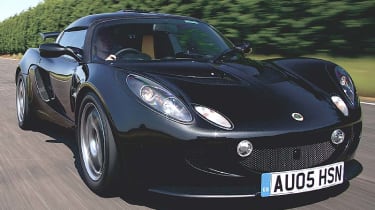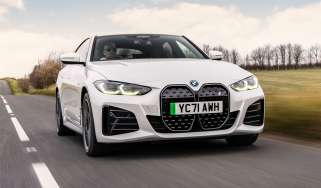Lotus Exige
Just 50 of these supercharged, 243bhp super-Exiges will be made and they're all already sold. Damn!
Imagine the frantic, fast-forward delivery of a highly-tuned Mitsubishi Evo, coupled with low-slung, lightweight responses, brick wall brakes and slick-like grip and you're getting close to appreciating what the Lotus Sport Exige 240R is like to drive. However, the most amazing thing about this cruelly limited-production supercharged Exige is that it almost never happened at all. At the 240R's heart is a supercharged version of the standard Exige's high-revving 1.8-litre Toyota engine, the product of work conducted by Lotus Engineering's Powertrain Research Team into the feasibility of 'Engine Downsizing'. The aim of this research was to create a small-capacity engine with the power and torque characteristics of a 3-litre; once the team's research paper was published, the engine might well have been pushed into a dark corner of the factory, never to be seen again. Fortunately for us, the guys at Lotus are an enterprising bunch, and it wasn't long before Chris Arnold, boss of Lotus Sport, suggested that the development engine's potential be explored further by dropping it into the back of an Exige test mule. Predictably it blew everyone away, and the project got the green light. All 240Rs start life as a line-built Exige, the work to convert it into a 240R completed as a post-registration conversion by Lotus Sport. The engine installation is especially impressive, for the compact, sealed-for-life low-pressure Eaton M62 supercharger snuggles up to the Toyota engine like it was designed-in from the start. So, too, does the intercooler and associated plumbing, which fits snugly beneath the standard rear clamshell. It also means that the Exige's originally cosmetic roof scoop is now fully functional, feeding the intercooler with plenty of fresh air. Just don't expect to see anything out of the rear-view mirror. The results are 22 per cent more power and 23 per cent more torque, lifting the Exige 240R's peak outputs to 243bhp at 8000rpm and 174lb ft at 7000rpm. Impressive figures for a 1.8-litre engine, and although they still arrive at high revs, what the on-paper stats don't say is that, thanks to a remap, the cam-change point drops to 4000rpm or so, compared with 6000rpm for the standard engine. That should make a real difference to the Exige's response and drivability. Apart from a discreet badge on the tail, the 240R's bodywork remains unchanged, but there's a host of detail tweaks that distinguish it from its normally aspirated brethren and ensure that its dynamics are more than a match for the increased performance. First and most obvious are the colour options: Sport Yellow and Sport Black, both of which have an unusually high metallic content and are unique to the 240R. New five-spoke forged alloy wheels (Satin black on the yellow cars, High Power Silver on the black ones) are a slightly wider diameter to accommodate slick tyres, for those who don't feel the standard fit Yokohama AO48s provide enough trackday grip. Pagid brake pads, high-grade silicon brake fluid and metal braided hoses provide increased stopping power and stamina, while Ohlins two-way adjustable dampers (with bespoke valving) and an adjustable front anti-roll bar enable you to optimise the damping for both road and track use. Look in the luggage compartment and you'll find an Accusump oil reservoir that acts as a safeguard should sustained cornering threaten to starve the engine of lubrication, while glance down at the rear diffuser and you'll spot the more prominent and slightly fruitier Stage One exhaust silencer. It takes all of three gearshifts to appreciate the 240R's huge performance gains. Where the standard car feels waspish and ravenous for revs, relying on you to keep it above 6000rpm before it feels genuinely quick, the 240R makes muscular progress on part throttle. Rather than viewing the final 2000rpm as the point where the action starts, the 240R is plenty quick enough if you short-shift at 6000rpm. Push the throttle harder and it reveals its explosive edge, power and acceleration building in intensity as you close in on 8000rpm. With the cam-change now lower down the rev- range, you don't get the pronounced kick as you do in the normally aspirated Exige, but the solid wall of thrust more than compensates, as does the engine note. It's an all-encompassing sound: loud, keen and completely in keeping with the Exige's steely-edged sense of purpose. Wind it right round to the 8200rpm limiter and the 240R positively shrieks, the Eaton blower's caustic whine bringing another dimension to the Toyota's already frantic soundtrack. Of course, no matter how furious, a four-cylinder engine can never sound as sonorous as a six, and so, inevitably, this Super-Exige doesn't possess the baritone bellow of a TVR, nor the respiratory burble of a Noble. That might be a source of disappointment to some, but one shouldn't forget that the 240R still comfortably undercuts the similarly road and track-biased Sagaris and M400, and is far from embarrassed against the clock, with 60mph hit in 3.9sec, 100mph in 9.9sec and a top speed of 155mph. With our road route completed, we head back to Hethel for some fast lapping of the famous test track. Having enjoyed the unexpected pliancy of the �hlins two-way adjustable suspension on road settings, it's all the more impressive to feel the difference a few additional clicks of bump and rebound can make on the track. It's also sobering to discover just how little of the 240R's ultimate cornering and braking ability you get to use on the public road. The beauty of the 240R, as in the rest of the Elise/Exige range, is that involvement is engineered into the whole driving experience, rather than compressed into the last few tenths. Tactile and malleable on the road, the 240R feels just as informative and confidence-inspiring on the track. The difference is that as you push harder and faster you really begin to explore the depths of the chassis' and tyres' ability, as well as the supercharged engine's abundant power. Despite the extra power and torque, traction remains mighty out of the tighter turns. Stay neat and tidy and the chassis is beautifully neutral, just nudging into faint understeer if you turn-in too fast, while squeezing on the power as the corner unfolds gets the rear-end working to its maximum, with a degree or two of oversteer as reward. More extreme provocation, such as a sharp lift of the throttle just as you turn in, will get the tail sliding, but true to Lotus form, the chassis still works with you to find a balance point that's easily held with plenty of opposite lock and a judicious right foot. Despite all this eulogising, £43,995 still seems like a lot to pay for an Exige. But, when you consider that a standard Exige kitted-out with the sports seats, up-rated brakes, exhaust, Ohlins suspension, air-conditioning and other goodies costs at least £36,000, a further £8K seems more than reasonable for what is one of the quickest, rarest and most accomplished cars Lotus has ever built. Perhaps that's why, just two days after the 240R's Geneva show debut, all 50 had been sold.
Specifications
| Engine | In-line 4-cyl, 1796cc, 16v, s/c |
| Max power | 243bhp @ 8000rpm |
| Max torque | 174lb ft @ 7000rpm |
| 0-60 | 3.9sec (claimed) |
| Top speed | 155mph (claimed) |
| On sale | You're too late |



